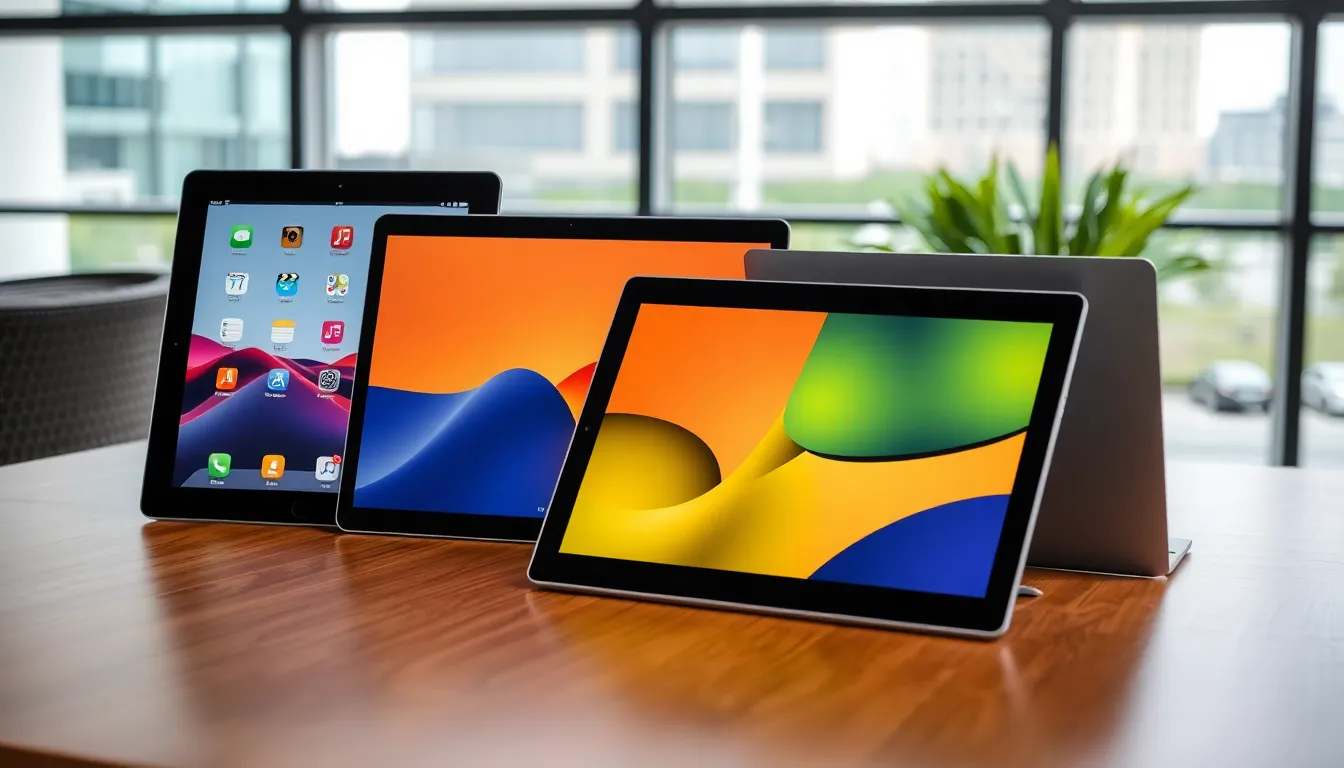Tablets have transformed the way people interact with technology, blending the functionality of laptops with the portability of smartphones. As versatile devices, they cater to a wide range of needs—from casual browsing and gaming to professional tasks and creative projects. Their sleek design and user-friendly interfaces make them accessible for users of all ages.
With a plethora of options on the market, choosing the right tablet can feel overwhelming. Factors like operating systems, screen size, and battery life play crucial roles in finding the perfect fit. Whether for work, education, or entertainment, understanding the unique features of various tablets can help users make informed decisions that enhance their digital experience.
Table of Contents
ToggleOverview of Tablets
Tablets serve as a bridge between laptops and smartphones, offering enhanced functionality in a portable form. Users benefit from their versatility in everyday tasks, making informed decisions crucial.
Definition and Types of Tablets
Tablets are portable touchscreen devices combining the features of laptops and smartphones. They usually run on mobile operating systems like Android, iOS, or Windows. Common types include:
- Standard Tablets: General-purpose devices for browsing, streaming, and light productivity.
- 2-in-1 Tablets: Devices that function as both tablets and laptops, featuring detachable keyboards.
- E-Readers: Tablets optimized for reading, with e-ink displays to reduce eye strain.
- Gaming Tablets: High-performance devices designed for gaming, featuring advanced graphics.
Key Features of Tablets
- Touchscreen Display: Provides intuitive navigation and interaction.
- Wireless Connectivity: Supports Wi-Fi and often cellular options for internet access.
- Portability: Lightweight and slim design enables easy transport.
- Battery Life: Typically lasts 8-12 hours, depending on usage and model.
- App Ecosystem: Extensive app libraries available across various platforms for productivity, entertainment, and more.
Popular Tablet Brands

Tablets dominate the market with several brands delivering innovative devices. The following sections provide insights into some of the most popular tablet brands and their offerings.
Apple iPad
Apple iPad remains a leading force in the tablet market. It ranges from the standard iPad to the Pro model, catering to various user needs. Key features include:
- Retina Display: High-resolution displays enhance visuals for gaming and media consumption.
- Apple Pencil Compatibility: Pro models support the Apple Pencil, ideal for artists and note-takers.
- iOS Ecosystem: Users benefit from seamless integration with other Apple devices and access to a vast app library.
Samsung Galaxy Tab
Samsung Galaxy Tab series is known for its versatility and advanced features. Several models cater to different budgets and preferences. Important aspects include:
- AMOLED Display Technology: High-quality displays deliver vibrant colors and deep contrasts.
- S Pen Integration: Most models include S Pen support, enhancing productivity for note-taking and sketching.
- Android Flexibility: Users enjoy customizable features with access to numerous applications tailored for productivity and entertainment.
Microsoft Surface
- Windows Operating System: Integration with Windows 10 or 11 allows for desktop-class functionality.
- Kickstand and Detachable Keyboard: Adaptive designs enable users to transition between tablet and laptop modes effortlessly.
- High-Performance Models: Devices like Surface Pro are designed for demanding tasks, including graphic design and software development.
Operating Systems for Tablets
Tablets operate on various systems, each offering unique features and capabilities. Understanding these operating systems helps users select the best fit for their needs.
iOS
iOS powers Apple tablets, notably the iPad. This operating system is renowned for its user-friendly interface and seamless integration with Apple services. iOS supports a vast array of apps from the App Store, allowing for flexible productivity and entertainment options. Key features include regular updates for security and performance, a robust ecosystem linked with iCloud, and optimized applications for touch functionality. Notable apps like GarageBand and iMovie enhance creative capabilities.
Android
Android is the operating system for a range of tablets, including those from Samsung, Lenovo, and Huawei. With its open-source nature, Android allows for extensive customization and a diverse selection of applications from the Google Play Store. This system supports various hardware configurations, making it suitable for tablets across different price ranges. Features such as split-screen multitasking and Google Assistant enhance productivity. Android’s flexibility enables manufacturers to implement unique skins and features, tailoring devices to specific user needs.
Windows
Windows tablets, like the Microsoft Surface series, run on the full Windows OS. This operating system supports traditional desktop applications, appealing to users needing functionality similar to laptops. Windows offers a versatile experience with features like the Microsoft Store for app downloads and integration with Microsoft Office services. The touch-optimized interface provides ease of use while supporting keyboard and mouse input for more demanding tasks. Additionally, Windows tablets often include features like file management capabilities, making them suitable for professional environments.
Current Trends in Tablet Technology
Recent developments in tablet technology reflect significant strides in performance and display capabilities. Manufacturers continuously enhance various features, focusing on delivering superior user experiences.
Performance Improvements
Tablets now feature advanced processors, such as Apple’s M1 chip and Qualcomm’s Snapdragon series, which provide faster speeds and improved energy efficiency. Increased RAM options, often ranging from 4GB to 16GB, support multitasking capabilities without lag. Integration of high-speed connectivity options, like 5G and Wi-Fi 6, enables seamless streaming and downloading experiences. Improvements in battery technology extend battery life, with many models offering up to 15 hours of usage on a single charge. Enhanced graphics processing units (GPUs) also cater to gaming and creative applications, allowing for improved performance in demanding tasks.
Display Advancements
Tablets increasingly utilize high-resolution displays, with many models featuring 4K or even 8K resolution for stunning visuals. OLED and AMOLED technologies enhance color accuracy and contrast, providing vibrant images and deep blacks. Adaptive refresh rates, often reaching up to 120Hz, improve the smoothness of scrolling and responsiveness, particularly during gaming or content consumption. Additionally, advancements in touchscreen responsiveness and precision create more fluid interactions, enhancing user experience in various applications. Anti-reflective coatings and blue light filters contribute to comfortable viewing, reducing eye strain for prolonged use.
Choosing the Right Tablet
Selecting the right tablet involves evaluating several key factors tailored to individual needs. By considering budget, use cases, and desired features, users can find a device that enhances their digital experience.
Budget Considerations
Budget plays a crucial role in tablet selection. Tablets range from budget-friendly models under $200 to premium devices exceeding $1,000. Evaluating what features matter most can help narrow options effectively.
- Entry-level tablets: Basic models like Amazon Fire Tablets and Lenovo Tab series offer essential features for browsing and media consumption at a low price.
- Mid-range tablets: Devices, including the Samsung Galaxy Tab A and iPad (standard model), provide improved performance and a better display while remaining affordable between $300 to $600.
- Premium tablets: High-end tablets like the Apple iPad Pro and Microsoft Surface Pro 8 deliver advanced capabilities, larger storage, and top-tier hardware, often costing more than $800.
Prioritize budgetary constraints to identify which features are essential without overspending.
Specific Use Cases
Considering specific use cases is vital in determining the right tablet. Different activities require different capabilities.
- Casual browsing and streaming: Standard tablets suffice for web surfing and video streaming, with models like the Amazon Fire HD or Lenovo Tab providing excellent value.
- Productivity: For professional tasks, the Microsoft Surface series and iPad Pro offer powerful performance, full software compatibility, and multitasking capabilities.
- Gaming: Gaming tablets like the Razer Razor or the Samsung Galaxy Tab S series feature high-refresh-rate displays and advanced processors to handle demanding applications smoothly.
- Reading and eBooks: E-readers such as the Kindle Paperwhite provide a focused reading experience with long battery life and glare-free screens, specifically designed for book lovers.
Identifying how the tablet will be used helps in choosing a device that meets expectations and enhances efficiency.
Tablets have revolutionized the way people interact with technology by offering a perfect blend of functionality and portability. Their versatility caters to a wide range of activities from casual browsing to professional tasks. With various types available users can find a tablet that meets their specific needs while considering important factors like operating systems and battery life.
As technology continues to evolve tablets are becoming even more powerful and user-friendly. By staying informed about current trends and advancements users can make educated choices that enhance their digital experiences. Whether for work or play tablets remain an essential tool in today’s tech-driven world.



